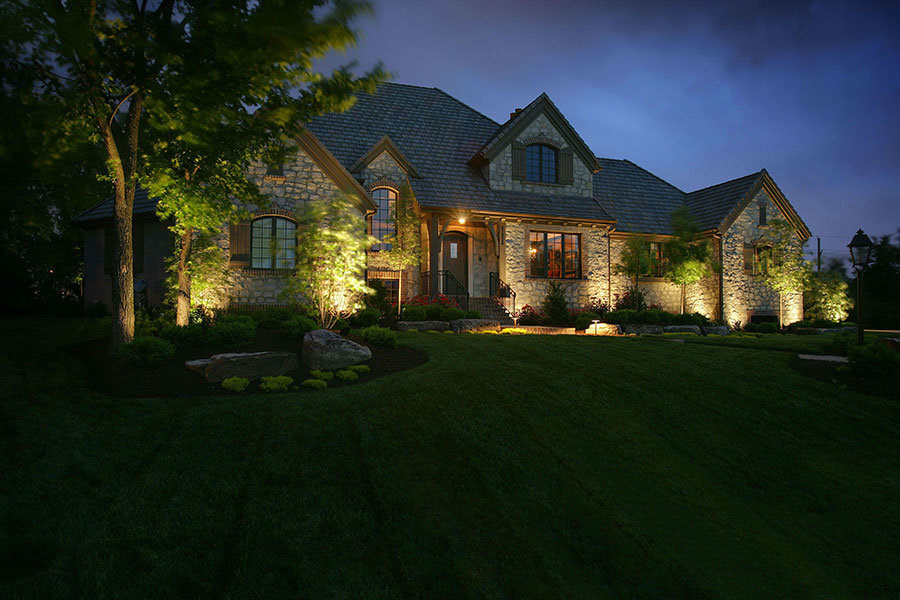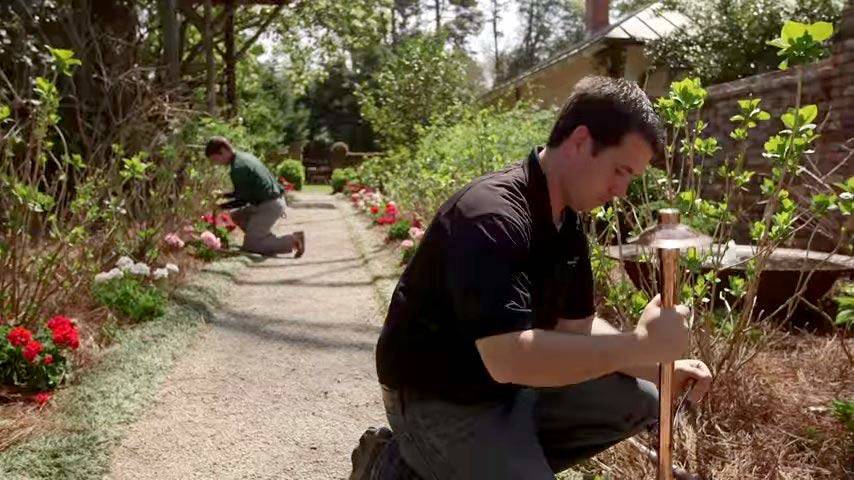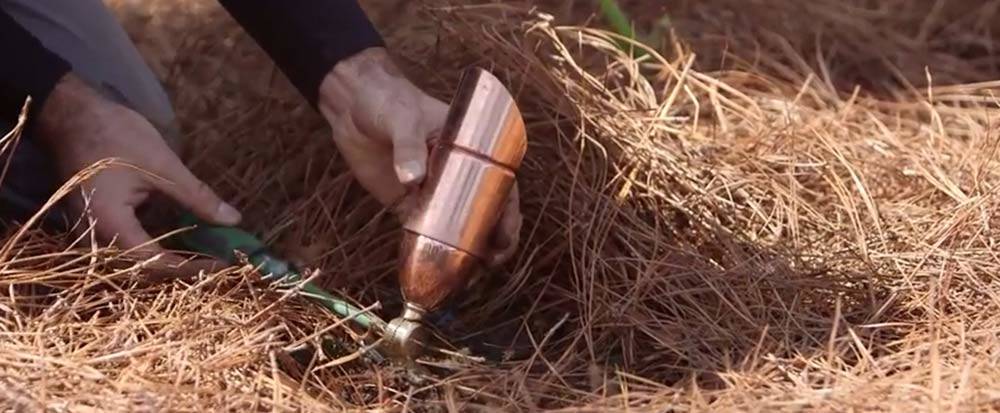Proper landscape lighting techniques can take your homes’ outdoors from ordinary to extraordinary.
Low voltage LED landscape lighting can create a more inviting atmosphere and enhance your home’s curb appeal. Proper lighting will change the entire feel of your outdoor space. Visually connecting different areas of your yard. When deciding on which outdoor landscape lighting you need for your home, try to keep in mind what to light, where, the best fixtures, and more!
Functionally outdoor lighting will also provide safety and security to your home. Learn more below!
Contact us online today to learn more!
Perhaps the most appealing aspect is that low voltage landscape lighting will completely change the way you use your yard. If your outdoor space is not being lit you cannot see it. What you cannot see, you cannot use. The problem is that undertaking a lighting project for your yard can be very intimidating.
Starting a Landscape Lighting Project
The first step in enhancing your home after sunset is to educate yourself about the possibilities. This includes considering:
- What you should light
- Types of landscape lighting
- Techniques to light your landscape
Good landscape lighting techniques are a classic case of less is more. Initially, you may consider lighting up every detail of your yard. However, this will wash the yard out. Not to mention the huge electric bill.
A well-designed space during the night has a balance between the light and dark.
You can take the opportunity to highlight features that are less noticeable during the day. You can create contrast and shadows using the shapes, structures, and plants in your yard. Proper use of these elements will create intrigue and drama. You and your guests will want to spend more time in these areas.
Choosing What You Should Light

With the exception is path lighting, your goal with landscape lighting should be to only see the effects of the light. Not the light source itself.
There are four things for consideration in deciding what to light in your yard.
Identify Your Favorite Features in Your Yard
Maybe it’s a statue or a sprawling tree. Highlighting those with light will show them off.
Add drama to areas that are not as noticeable during the day
When grazed with light and shadow, a basic stone wall in the day can become a unique and intriguing look at night.
Consider Functionality
Outdoor stairs and pathways have to be lit for the safety of you and your guests.
Create Well-lit and Inviting Entryways
The entrance to your home should always be properly illuminated. Outdoor wall sconces will create a warm and welcoming curb appeal, and safely guide guests to your doorway.
Types of Outdoor Lighting

Once you decide on what to light, you must decide on how to light it. There are several core types of fixtures to consider when creating a lighting plan.
Pathway and Walkway Lights
Pathway and walkway lights are the most common type of landscape lighting. They are small posts with a built-in light and capped with a diffuser. They can be spaced along a pathway or used to frame an area or feature in your yard. You can line them down a walkway, around a pond, or outline your driveway.
Post Mount and Pier Mount Lights
Postmount lights are designed to install onto a post or on top of a structure. They are great for situations where more architectural light is needed. They are often used for gates, fences, entrances, or around a deck.
Deck and Step Lights
Deck and step lights are usually installed directly into your hardscape or decking. They are often used to accent an architectural detail or to add a safe guide dark stairs. You can also use them to wash light down exterior walls or to light up spaces for entertainment.
Bollard Lights
Add bollards lights as a feature to accent and illuminate walkways, landscaping, buildings, and parking areas. They are great to stylize an area or to create an architectural look. You can use them as guideposts around a space, or to separate your driveway from your yard.
Spotlights
Spotlights can highlight many outdoor features. These may include trees, buildings, sculptural and architectural details. The beam of light from a spotlight is narrow and usually no wider than 45 degrees. Making the light more concentrated and easier to point and control.
Floodlights
Floodlights can illuminate a larger amount of space with the same wattage and lumen output as a spotlight. The spread of the beam can reach up to 120 degrees. As such, they can be also incorporated into the safety of your home from intruders.
Well Lights
Well lights are a variant of the spotlight. They are mounted in the ground and are used to uplight trees, buildings, and large plant material. These fixtures are very versatile.
Underwater Lights
Similar to the spotlight. However, these lights are made to be submerged in water. Adding real drama to your outdoor water features.
Hardscape Lights
Hardscape lights are a newer form of landscape lighting. They are small lights with flanges or brackets that install into or onto structures. They are used to graze and wash walls with light.
Landscape Lighting Techniques

Great fixtures are only the first step. How you use those fixtures makes all the difference. The landscape lighting techniques below are staples to achieving unique and dramatic looks. Mix and match them for the perfect look for your home.
Pathway Lighting
Pathway lighting may seem like a pretty basic landscape lighting technique. However, it can easily be implemented wrong. Consider how many lights are really required. You will often find too many lights are used for a project. This creates an over-lit space which often feels cramped. Try to place your fixtures on either side of the path. Work back and forth to create a safe and inviting entryway.
Acheive this look with pathway lights and bollards
Uplighting
Uplighting a more basic technique of landscape lighting. This is when landscape lights are mounted below or at ground level, shining the light upward. It creates drama with taller structures or larger trees.
Acheive this look with spotlights and well lights
Silhouetting
Silhouetting is done by placing the light source behind the item, where it cannot be seen. The light is pointed toward the main vantage point. This is a great way to highlight dramatic shapes you might not see in plain daylight.
Acheive this look with spotlights and well lights
Shadowing
Shadowing can create a softer, more moody effect. It is the opposite technique of silhouetting. The light is placed between the item being lit and the main vantage point. The light source is then aimed at the item. To maximize the effect you will want a wall or flat surface behind the item being lit. It will catch the shadows created by the highlighted piece.
Acheive this look with spotlights, floodlights, and well lights.
Moonlighting
Moonlighting is achieved by mounting downlights high in nearby trees. The effect can be enjoyed no matter the vantage point. On an open-branched tree, this can create a very impressive effect.
Acheive this look with spotlights
Grazing
Grazing is a technique that involves placing the light close to the flat surface. You can aim it directly up or down the surface to create dramatic light and shadow play. It allows you to show off the interesting textures in your walls, and increase security in darker areas. You will often see this technique in hotel and restaurant design.
Acheive this look with well lights, spotlights, and hardscape lights
Washing
Wash lighting brings your landscape all together after dark. Place a light with a wide-beam between the main vantage point and a surface. This will create a soft and even light over the entire area.
Acheive this look with floodlights
Summary
Landscape lighting is an intimidating project to take on. But it all starts with the right types of lights and landscape lighting techniques. From there you can design the perfect layout for you. Enhancing your homes’ curb appeal, safety, and functionality.
With the information and techniques above you can now start your own landscape lighting layout.
Once you have your layout, make sure that you consult with a professional outdoor lighting expert.
There are still issues such as the right voltage and transformers and other important electric and functionality details. Consulting a professional will save you time and money in the long run.